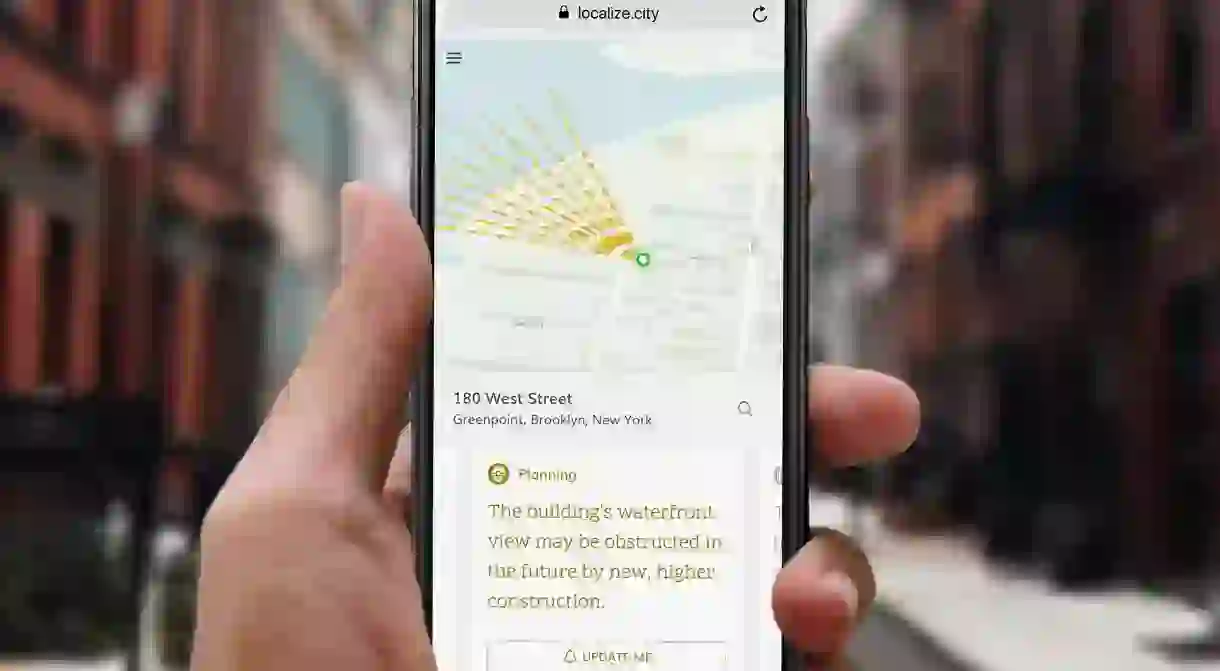This AI-Powered Website Gives Insight Into Any Neighborhood in NYC

A new website “reveals the truth” about your building and neighborhood – and it just may change the way apartment hunters find their new digs.
In what may be the fastest-moving rental market in the United States, most New Yorkers don’t have time to research every aspect of their neighborhood before committing to a new lease. If an apartment meets even half your needs, it’s more common to just sign on the dotted line, hand over the deposit, and consider yourself lucky, rather than ask questions about noise complaints and the status of neighboring high-rise development.
Localize.city, an AI-powered (free) website that launched this week, offers transparent, real-time insight into New York City’s neighborhoods, including future construction plans, noise pollution, local population demographics and even building complaints – in a matter of seconds. Their technology may not only change how New Yorkers pick their next neighborhood, but also how long-term residents stay up-to-date on the ever-evolving cityscape.
Steven Kalifowitz, president of Localize, expects to bring the technology to five to ten more cities by the end of the year, eventually covering the entire United States.
But what is it about New York City that makes this particular AI technology so essential? “New York has an amazing number of real estate transactions per year – it’s extremely high, relative to other cities,” Kalifowitz tells me. “It’s an extremely dynamic city with a constant influx of newcomers who need a place to live and don’t know the city. Even long-time locals don’t know what’s going on because of how quickly things change here.”
“When we set out to build this product, we wanted to communicate with people in a human, conversational tone. A lot of the data that we’re using is very complex stuff, but we have a team of urban planners and data scientists with PhDs to write these algorithms and simplify [the end result],” Kalifowitz says, who oversees a team of 100 people in NYC and Tel Aviv.
“The answer is not more data. The answer is actually giving [users] something simple and easy-to-read, where they feel like they can consume and make a decision. That’s why the design of the product includes a map that moves, to illustrate what we’re saying.”
Localize technology can reportedly analyze thousands of data-sets in real-time, needing only an address to work its magic. Users can then swipe through straight-forward, conversational data points on any given building or neighborhood. There’s even a little map that highlights targeted areas, like nearby Citi Bike locations, school zones, and development proposals.
A search of 520 W. 28th, Zaha Hadid’s new Chelsea condos, reveals nearby construction plans for five new buildings, a moderate risk of flooding, and points out how the influx of new housing developments in Hudson Yards may change the area’s character.
“People need to make quick decisions about where to live with little information. People who’ve been here a long time don’t always know what’s going on around them. New York is a perfect test case and has a lot of data for us to work with. It was important for us to come here first,” Kalifowitz says. The service will remain free of charge for the public, with a predictive framework that can assess the impact of future changes to the area.
Localize‘s algorithm pools data from everything from 311 complaints to traffic patterns, producing a predictive forecast of the ebbs and flow of a neighborhood. Since most people apartment hunt on the weekends or on “off peak” hours, they don’t really get to experience the full-scope of a prospective neighborhood. But when asked how all that data is mined and immediately translated into easy-to-read points, free of charge to the public, Steve can’t help but joke: “I’d have to kill you if I told you.” He’s very much aware of his product’s potential for not only New Yorkers, but also the global residential and sales markets.
Kalifowitz cites the fact that consumers can Google detailed information about even the most minor retail purchases in order to properly inform themselves – but what about the biggest investment of all? What about where you live? And what will it be like to not only live in that neighborhood today, but also in the near future? “Home buyers and renters are forced to choose their new home without knowing what life will be like after moving in,” he continues.
“We all know someone who paid a premium to be near a subway that closed for construction two months later or a friend who thought they were moving to a quiet street, until the first night when trucks rumbled by at 2am. Localize will help all New Yorkers choose their next home without suffering from such problems,” says Kalifowitz.
New Yorkers everywhere can, at the very least, breathe a sigh of relief that there’s a new “neighborhood” tool out there that can help inform their next move. And that’s a step forward.













